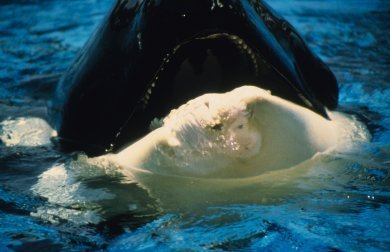Mark Caney's Blog, page 34
August 8, 2013
Dolphins can recognize whistles from old tank mates from over 20 years ago, study finds
Dolphins have long impressed people with their sharp minds and humanlike traits, such as calling each other by name, goofing off and even understanding numbers. Now a scientist has found that the mammals can recognize an old friend’s whistle, even after they have been apart for 20 years — the longest social memory ever recorded for a non-human.
In a study released Tuesday, dolphins largely ignored calls from unfamiliar dolphins but responded when an old tank mate’s signature whistle was played back to them. It didn’t matter how much time had passed since the two had last seen each other or whether they had been tank mates for only a few months: The dolphins appeared to remember a familiar whistle.
Read full story with video: Washington Post

August 6, 2013
Dolphins have ‘longest social memory’ among non-humans
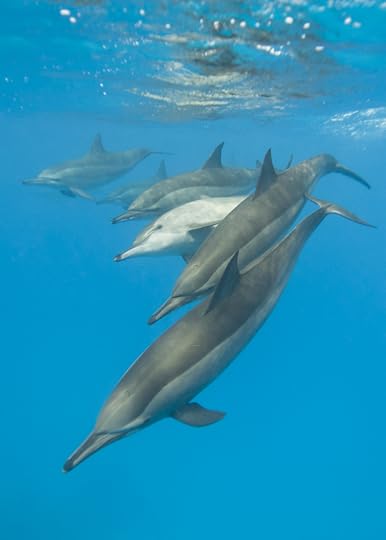 Forget about elephants – scientists say that dolphins have the longest memories yet found in a non-human species.
Forget about elephants – scientists say that dolphins have the longest memories yet found in a non-human species.
Researchers in the US say that even after 20 years of separation, dolphins could recall the whistles of former companions.
The authors believe that these long-term memories are a product of the complex social connections that dolphins have evolved.
The research is published in the Proceedings of the Royal Society B.
In the study, the scientists used information on the relationships between 56 captive bottlenose dolphins that have been moved for breeding purposes between six different zoos and aquariums in the US and Bermuda.
The researchers then played recordings to the dolphins on underwater speakers of the signature whistles of animals they had once lived with, and measured their responses.
“When they are familiar with the call, the dolphins are more likely to approach the speakers for longer periods of time,” said Dr Jason Bruck from the University of Chicago who carried out the study.
“They will maintain contact with the speaker – if they are unfamiliar with the call they are more likely to ignore what I am playing. It’s unprecedented in the study of animal behaviour to find memories this long.”
Dr Bruck highlighted the case of two female dolphins called Allie and Bailey. They had once lived together in the Florida keys when they were very young
Bailey now lives in Bermuda but when a recording of Allie was played, she instantly responded in even though it was was 20 years and six months since they had been in contact.
Dr Bruck says this type of response was typical. Compared to unfamiliar calls, there was a clear pattern in the data where dolphins responded significantly more to whistles from animals they had once known, even if they hadn’t seen or heard them in decades.
To check that the dolphin’s response was due to recognition of a former companion, Dr Bruck would also play a test recording of an unfamiliar bottlenose that was the same age and gender as the familiar animal.
Nuclear family
The researchers believe that the complex nature of dolphin social systems is behind the long term memory effect.
In the ocean, dolphins have a fluid social arrangement that scientists term a “fission-fusion” model. They may leave one group and join others many times in their lifetimes.
Full story: BBC

August 5, 2013
I helped rescue a dolphin which is why I don’t eat seafood
By now, most people have seen or heard about the viral video of two anglers freeing an endangered whale who was entangled in fishing gear, possibly sea-bass or lobster traps, off the Virginia coast. The whale – North Atlantic right whale No. 3123, one of fewer than 400 of her kind in existence – wasn’t the first marine mammal to have become entangled in fishing gear, and she certainly won’t be the last. In fact, such unintended victims of fishing nets, lines and traps – so-called “bycatch” – are one reason why I don’t eat seafood. I came face to face with one of those victims myself more than 15 years ago.
My husband and I were cruising on our 35-foot sailboat on the Intracoastal Waterway near Charleston, S.C., when we heard a call come over the radio about a distressed dolphin just ahead of us. We soon came upon the small dolphin, who was hopelessly entangled in what appeared to be a crab pot. The youngster was obviously exhausted and barely able to summon the strength to surface for air. We radioed the Coast Guard but were told it wouldn’t be able to get anybody out for a couple of hours. Looking at the young dolphin struggling to breathe, we feared that he wouldn’t be able to hang on for that long.
We set out an anchor, and my husband hung off the transom with a knife and began sawing away at one of the lines. It was extremely difficult work, since every time he picked up the line, which was wrapped around the dolphin’s tail, it forced the dolphin’s head underwater, and he thrashed in panic. Finally, the line broke, and the dolphin immediately sped forward – but he wasn’t free of all the lines and buoys yet. Right about then, some men in a small motorized skiff came along, and my husband “commandeered” it to pursue the dolphin and remove the rest of the lines. “The dolphin is free,” we later radioed, and cheers went up across the airwaves.
This dolphin and the rescued right whale are not anomalies. According to the National Oceanic and Atmospheric Administration, more than 100,000 marine mammals and a staggering 1 million seabirds die every year because of ingestion of and entanglement in marine debris.
Commercial fishing practices are highly efficient – and highly destructive. Factory fishing trawlers use enormous nets that vacuum up everything in their path. Such nets are believed to be responsible for the deaths of nearly 1,000 marine mammals every single day.
Longline fishing for tuna and swordfish – in which dozens of miles of fishing line is barbed with thousands of hooks – “accidentally” kills hundreds of thousands of sea turtles, sharks, dolphins and albatrosses every year.
Shrimp trawlers may throw up to 85 percent of their haul back into the sea, making shrimp perhaps the most lethal seafood that a person can eat.
Thanks to such rapacious overfishing, the population of the world’s large predatory fish, such as tuna, swordfish, flounder and cod, has been decimated by 90 percent since 1950. According to the Food and Agriculture Organization of the United Nations, nearly 80 percent of the world’s fish stocks for which data are available are fully exploited, overexploited or depleted.
Personally, I cannot support such wholesale slaughter on the high seas. Fish are intelligent animals and have been documented using tools. Recent research indicates that dolphins come up with distinct names for each other. An all-you-can-eat meal at the seafood buffet is simply not worth snuffing out the life of one of the last few right whales or loggerhead sea turtles or causing a dolphin to drown in panic.
ABOUT THE WRITER
Bobbie Mullins is a retired office manager in Norfolk, Va. She wrote this for People for the Ethical Treatment of Animals, 501 Front Street, Norfolk, Va. 23510; www.PETA.org. Information about PETA’s funding may be found at www.peta.org/about/numbers.asp.
Full story: Island Packet

July 28, 2013
Girls help rescue dolphin
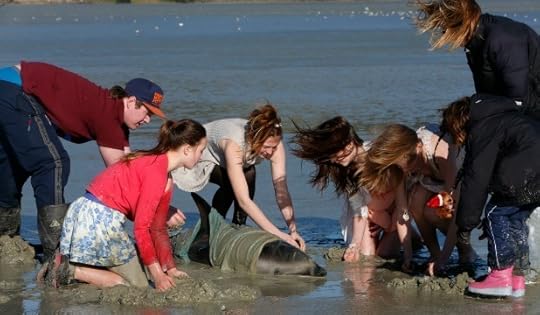 Nelson girl Jacqueline Austin, 11, will be able to tell her class about how she helped save a juvenile dusky dolphin when she goes back to school next week.
Nelson girl Jacqueline Austin, 11, will be able to tell her class about how she helped save a juvenile dusky dolphin when she goes back to school next week.
Her mother Fran Bishop said she, Jacqueline and sister Laeticia, 9, were walking their dogs at the Boulder Bank, New Zealand, when they spotted a pod of four dolphins just offshore.
She said she decided to keep an eye on the dolphins in case of strandings as the winds were “ferocious”, and sure enough, on their way back Jacqueline spotted a baby dolphin stuck in the mud at low tide.
“I said I thought it was a stick, and Jacqueline said, ‘No, it’s a shark, it’s a shark’.”
Avid fans of nature documentaries such as the late Steve Irwin’s The Crocodile Hunter, the girls were able to put their knowledge into practice during the dolphin’s rescue. The family called the Department of Conservation and Nelson SPCA before spreading towels from their car across the dolphin to keep it moist.
Ms Bishop said her daughters knew to keep away from the animal’s tail in case it hurt them while thrashing.
“We’re all still on a high,” she said afterwards. “That’s a good story to go back to school with.”
DOC ranger Simon Bayly said Ms Bishop and her family did everything right in their dolphin rescue. He said it simply got “caught out” by the outgoing tide and shallow water.
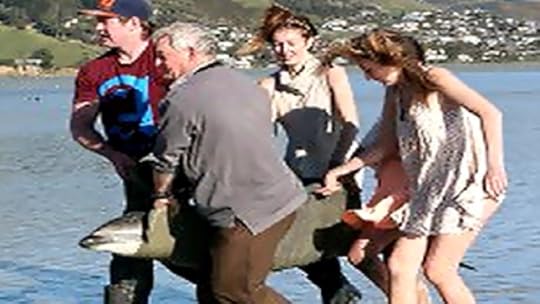 With the help of four young people who stopped their car to assist, Mr Bayly, Ms Bishop and the girls carried the dolphin around 100 metres through the mud to get it into a DOC van. It was then transported to a boat ramp at Nelson Marina and released.
With the help of four young people who stopped their car to assist, Mr Bayly, Ms Bishop and the girls carried the dolphin around 100 metres through the mud to get it into a DOC van. It was then transported to a boat ramp at Nelson Marina and released.
Mr Bayly said he thought the refloating was likely to be a success. “It was very healthy, it didn’t hesitate to swim off when we let it go.”
Project Jonah representatives stayed at the marina to make sure the dolphin did not re-strand.
Source: Nelson Mail

July 25, 2013
Blackfish Movie Review
A review of the new Blackfish movie by Rob Lott of WDC:
Three deaths, two decades, one whale. What have we learned?
In one of the most powerful and thought-provoking documentaries in a generation, Blackfish turns the spotlight on humankind’s selfish desire to confine large, intelligent marine mammals in a captive situation for our viewing pleasure. Gabriela Cowperthwaite’s important film could have so easily been labelled ‘just another activist film’ but this is different. The film’s narrators are mostly ex-employees of the multi-million pound captive marine mammal industry who have decided to speak out on the culture, management style and insidious PR machine that exists at one of America’s most identifiable brands – SeaWorld.
Many of these trainers left the captive marine mammal industry years ago, have since established new careers, and had no financial interest in speaking out in Blackfish. The film draws aside the thin façade that hides the dark underbelly of the captivity industry and arms the filmgoer with the hard facts allowing them to finally dispel the myth behind the Shamu label.
The ex-trainers in Blackfish candidly describe their experiences of working at SeaWorld and eloquently convey how frustrated they came to feel after starting work there and how dismissive and even oppressive SeaWorld’s senior management could be if trainers failed to toe the corporate line. The trainers in Blackfish acknowledge that they privately questioned whether the captive whales at SeaWorld were behaving normally and whether working practices recommended by their managers were appropriate and safe, but didn’t dare voice these concerns for fear of jeopardising their own positions and careers.
Read the full article: WDC

July 20, 2013
Isle of Man Risso’s dolphin encounter ‘a rare privilege’
Marine researchers have described a “privileged encounter” after photographing 15 Risso’s dolphins, about one mile from the Manx coastline. Manx Basking Shark Watch (MBSW) scientists came across a pod of 14 adults and one juvenile on 12 July. The Risso’s group, which consisted of several large males, was spotted near The Sound off the south coast. Jackie Hall from the MBSW said: “This was the best Risso’s dolphin encounter we have ever had.” She added: “They repeatedly came right up and under the boat to take a look at us – it was amazing, a total privilege to be observed by such beautiful animals.”
A recent survey suggested warmer seas could be responsible for a change in the type of dolphins being spotted off the northern shores of the British Isles. The North East Cetacean Project found an increase in sightings of common, bottlenose and Risso’s dolphins – species associated with warmer waters. “Record week” At the beginning of the summer, the Manx Whale and Dolphin Watch recorded a “record week” in terms of dolphin sightings around the Manx coast.
On 25 May a pod of more than 60 individuals, including calves, was filmed off the north coast. The group included Risso’s and Bottlenose dolphins. “Their dorsal fins were so big that for a fleeting moment we wondered if they were Orca, it is easy to see how the big male Risso’s are often misidentified,” said Mrs Hall.
Risso’s dolphins are identifiable by their scarred skin caused by other Risso’s dolphins who use their front teeth when playing and fighting. They have stocky heads without a beak and are light grey to white with a white chin.
Source: BBC

July 13, 2013
New Virus Discovered in Stranded Dolphin
Researchers at the Center for Infection and Immunity at Columbia University’s Mailman School of Public Health and colleagues have identified a new virus associated with the death of a short-beaked dolphin found stranded on a beach in San Diego, USA. It is the first time that a virus belonging to the polyomavirus family has been found in a dolphin. Results appear online in the journal PLOS ONE.
Polyomavirus is known to cause disease in birds, but in mammals it is usually mild or subclinical, explains lead author Simon Anthony, PhD, a researcher in the Center for Infection and Immunity at the Mailman School. “It is therefore interesting that this particular polyomavirus appears to be what killed this dolphin. It’s no immediate cause for alarm, but it’s an important data point in understanding this family of viruses and the diseases they cause.”
This discovery will help prepare scientists for future disease outbreaks and could even be useful in solving past unsolved cases. “There are many cases of disease in animals that we never have solved,” says Dr. Anthony. When we make a new discovery like this, it allows us to ask, Have we seen it before? Will we see it again?”
The dolphin, a female calf, was found dead in October 2010. Judy St. Leger, DVM, of SeaWorld in San Diego, a co-author of the study, conducted a necropsy that identified the cause of death as tracheal bronchitis with signs of an infection, which an electron microscope revealed to be of possible viral origin. To identify the culprit, she sent a biological sample to the Center for Infection and Immunity in New York, where Dr. Anthony used high throughput DNA sequencing and a number of other techniques to identify the novel polyomavirus.
Genetic analysis showed that the polyomavirus in the San Diego dolphin was distinct from other members of the virus family. Drs. Anthony and St. Leger postulate that this might be one of many such viruses that exist in dolphins and other marine mammals. They are now searching for more examples of polyomavirus in dolphins. “It’s possible that many dolphins carry this virus or other polyomaviruses without significant problems. Or perhaps it’s like the common cold where they get sick for a short while and recover,” says Dr. St. Leger.
Dr. Anthony stresses that without more work to study the diversity and prevalence of polyomaviruses in dolphins and other marine mammals, it is difficult to know what the specific threat of this new virus is. ”We don’t even know if this is even a dolphin virus. It could also represent a spillover event from another species.” While unknown in this case, the possibility intrigues him. “Several important outbreaks in the past have resulted from viruses jumping into new hosts,” he says, citing another Anthony-St. Leger collaboration where they documented a case of bird flu in a seal population in New England (findings were published in mBio).
But for now, the significance of the discovery of a polyomavirus in a dolphin is that it appears to be the cause of death of this animal, and as Dr. Anthony notes, “One of our main goals is to protect the health of wildlife.”
Source: Science Daily

Dolphin Makes Early Break for Freedom From Korean Rehab Facility
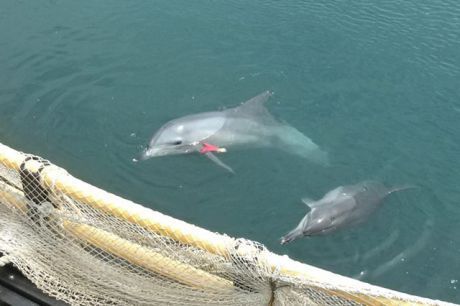 This is the story of a dolphin named Sampal.
This is the story of a dolphin named Sampal.
Sampal is a creature that spent the first decade of her life in the waters around Jeju Island, off the coast of South Korea. Sadly, abuse and exploitation have featured heavily in her life. But her story also has a happy development, one that should give us pause when considering how we treat these beings of the sea.
When Sampal was about ten years old, she was accidentally captured in one of the numerous fishing nets in the waters around the island. Rather than being released, she was illegally sold to the Pacific Land Aquarium, where she spent roughly three years confined to a tiny subterranean pool. Kept hungry, she was forced to perform daily by doing tricks that would be rewarded with food, as is routine practice at captive dolphin facilities.
About a year ago, thanks to the efforts of individuals such as Seoul Mayor Park Won-soon, Sampal and her two companions at Pacific Land were ordered by the Korean High Court to be returned to their home waters. The dolphins were transferred to a temporary sea pen this May for rehabilitation and an eventual release, which was officially scheduled for sometime later this summer.
The rehabilitation and release project, facilitated by a group of organizations and institutions such as the Korean Animal Welfare Association, Ewha University and the Cetacean Research Center, was going according to plan.
Ric O’Barry, director of Earth Island Institute’s Dolphin Project, was invited to Korea in order to assess the physical and psychological state of the dolphins and was pleased with their progress.
“They need to be un-trained what they learned at Pacific Land and retaught how to live in the ocean,” said O’Barry, while predicting that the dolphins would fare well once they were returned to their home range.
However, on June 22, about a month into the rehabilitation, the netting of the sea pen tore open, resulting in a gap large enough for a dolphin to swim through. Sampal took advantage of the situation and left the pen. She hung around after her escape, but as a group of people gathered at the pen to ascertain how to get her back inside, she swam for the open ocean and did not return.
While there was great concern for her wellbeing, with some fearing that she was not ready to be returned to the ocean, the Cetacean Research Institute reported a confirmed sighting of Sampal on June 27. She was spotted 100 kilometers away from the sea pen, swimming with a pod of about 50 dolphins—the very ones from whom she was taken all those years ago.
Full story: Take Part

July 11, 2013
Dolphins May ‘See’ Pregnant Women’s Fetuses
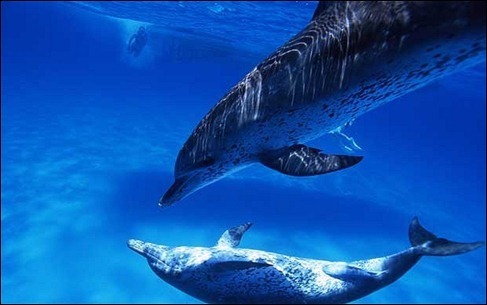 Using echolocation, dolphins might be able to detect a pregnant woman’s developing fetus, some experts say.
Using echolocation, dolphins might be able to detect a pregnant woman’s developing fetus, some experts say.
Dolphins emit sounds in their environment and listen to the echoes that return — a process that helps them identify the shapes and locations of objects. Doctors use a similar technique to image a developing human baby. Both involve ultrasound — high-pitched pulses of sound above the range of human hearing.
“I think it’s extremely plausible [dolphins] would be able to detect a fetus,” said Lori Marino, a neuroscientist at Emory University in Atlanta who studies cetacean intelligence. However, “you’d have to really do a well-controlled study to make a definitive statement,” she cautioned.
Fetal buzz-ogram
Anecdotal reports suggest dolphins take a special interest in pregnant women. The animals supposedly swim up to the expecting women and make buzzing sounds near the women’s tummies. “Buzzing” is a form of very concentrated echolocation. When the dolphins want to hone in on something or stimulate another dolphin, they put their snout against the skin and buzz, Marino said, adding, “It sounds like a squeaky door.”
Malcolm Nicolson, a history of medicine professor at the University of Glasgow in Scotland, agreed that dolphins may be able to detect a human woman’s pregnancy. For instance, a dolphin that swims with a female trainer before and after she becomes pregnant “might well be able to detect a difference in her echo profile,” or the pattern of sounds returned by echolocation, Nicolson said. Dolphins might even have the ability to detect a fetal heartbeat in a woman they have never bumped up against before, he added. But Nicolson, who wrote a book on the development of obstetric ultrasound, noted that this was only speculation.
At least one study has found that dolphins can perceive shapes through an opaque barrier, such as a box. “It would seem logical that they would have the potential to discriminate between different humans” who are pregnant or not, said Mike Walsh, an aquatic animal veterinarian at the University of Florida. After all, water is the perfect medium for ultrasound, Walsh said. Still, the dolphins may not know that what they’re seeing inside the pregnant woman is a person, he said.
Marino said she thinks dolphins probably see some sort of image of the baby. “We know from other studies that they are very good at going from a visual image to an acoustic image,” and vice versa, Marino said. Just as sonograms give people a visual image of their babies, echolocation might give dolphins a mental image of them.
By extension, it’s quite possible that dolphins can detect pregnancies in other dolphins, Marino said. Indeed, the animals have been seen buzzing on other pregnant dolphins. Dolphins use echolocation for many different purposes, from communicating in a group to disciplining their offspring, Marino said, adding, “They’re always buzzing!”
Dolphin abilities
Dolphins probably aren’t born with their echolocation ability, but develop it over time. Baby dolphins, for instance, babble before they learn to make more complex sounds, Marino said. She suspects their echolocation must be learned as well.
Even though dolphins might be able to detect a pregnancy, giving birth near dolphins may be a bad idea, as the meat-eating marine mammals are known to sometimes be aggressive, scientists say.
Full story: LiveScience

June 28, 2013
“Dolphin Way is the best book I’ve read this year”
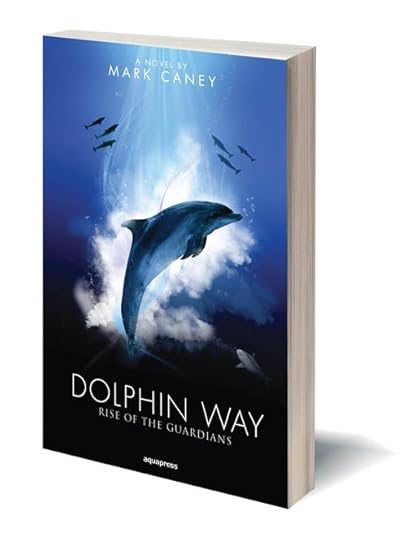 We are always pleased to hear of readers’ comments after they have read Dolphin Way. Here is another comment posted on Amazon by “Tigercub” in the last few days:
We are always pleased to hear of readers’ comments after they have read Dolphin Way. Here is another comment posted on Amazon by “Tigercub” in the last few days:
“I’m not sure what I was expecting when I sat down to start reading Dolphin Way. I hadn’t read any reviews at that point. I had received the book as a gift from someone who knew I typically only read SF and fantasy, but took the chance anyway and gave it to me. In part out of obligation to her, I started reading. I’m damned glad I did. Dolphin Way is the best book I’ve read this year.
For a guy who seems to have spent most of his time in the ocean, rather than at a type-writer, Mark Caney writes very well indeed. From the start, I was grabbed by his vivid description of the underwater world. It’s familiar, of course, being the oceanic world of our own planet, but at the same time so alien because, to the dolphins at least, it is everything. The land so important to us features so little in the book.
It wasn’t just the setting that seemed alien, of course. In those moments when the book truly shines, the dolphin society is convincingly alien, too, and portrayed with all the skill that a great science-fiction writer puts into his or her imagined alien species.
In fact, part of why I loved Dolphin Way so much is that it reads exactly like a great SF novel. All the elements are there – from the alien world of Earth’s oceans to the society of a species whose existence, history and experience are so far removed from our own, from a genuinely well-crafted hero to a dark and dangerous nemesis. The social interactions between the dolphins are rich and compelling. Their rites and legends and the mystique surrounding whales in their culture is all gripping stuff.
Everything a good read needs is right here. And, like most great SF, it’s not all simple entertainment or escapism – it will make you think every time you close the cover. What do dolphins think of us? Given the atrocities certain nations perpetrate against their species to this day, probably not that much. And yet they show no contempt towards us. How well do they know us? Their species is far older than ours. Do have creation myths? What are they?
Dolphin Way may not be SF in the traditional sense, and some would say it isn’t really SF at all, but it’s one of my favourite SF books all the same, and I encourage you to read it as soon as possible. Enjoy!”


